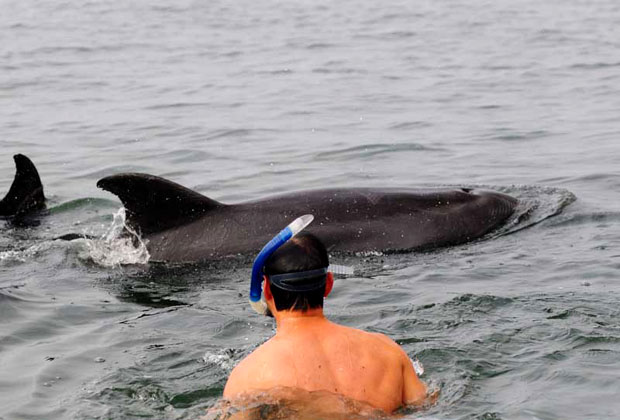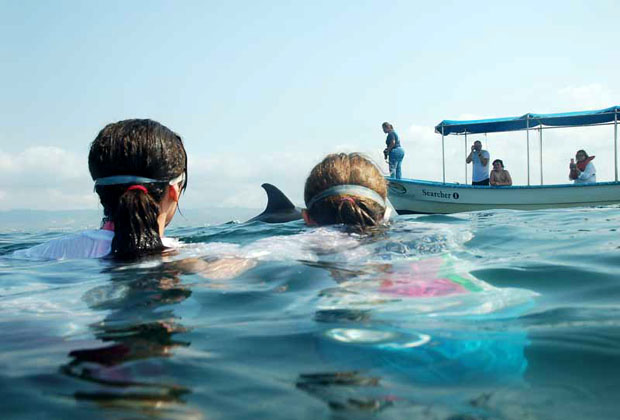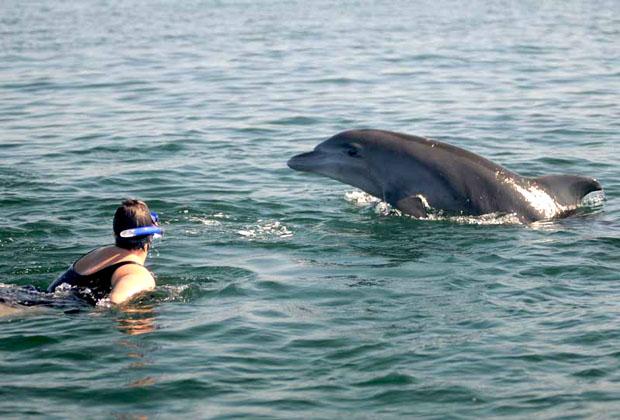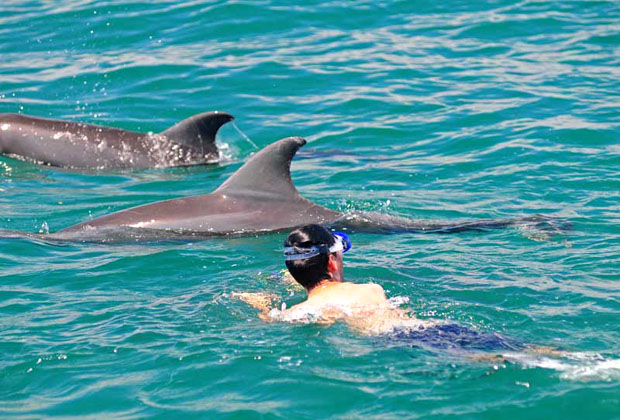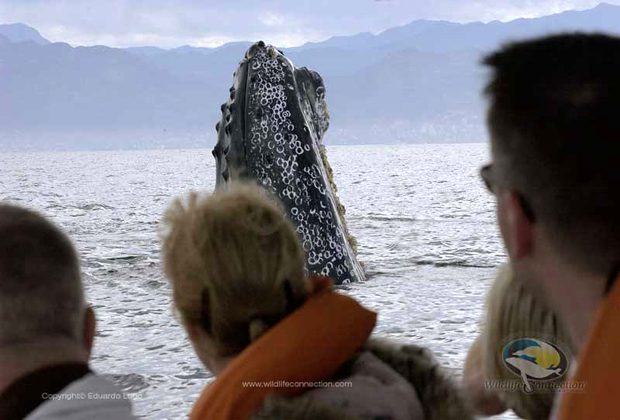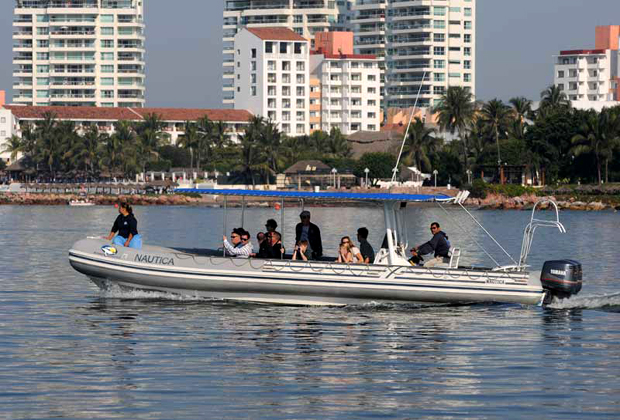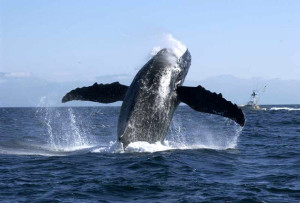 The Bay of Banderas is a place filled with natural marvels, mountains cove-red with dense tropical forests teeming with a great variety of flora and fauna, idyllic beaches, waters rich in marine life and islands with hundreds of birds nesting upon them… But there is no doubt that its most treasured jewel is the Humpback Whale.
The Bay of Banderas is a place filled with natural marvels, mountains cove-red with dense tropical forests teeming with a great variety of flora and fauna, idyllic beaches, waters rich in marine life and islands with hundreds of birds nesting upon them… But there is no doubt that its most treasured jewel is the Humpback Whale.
These gentle giants visit this zone every year during the winter as this is where they find ideal conditions for their reproduction. As the first whales arrive around the end of November, they be-come familiar with the place, timidly at first, then they start congregating. As the weeks go by and the number of animals rises, activity increases and one of the most extraordinary spectacles of nature begins. The males of this species sing songs that can be heard underwater throughout the bay and in an extensive area outside of it. It is one of nature’s most beautiful sounds and the loudest and strongest made by any animal.
The purpose of this serenade is to attract the females. Once the female comes close, the male begins to swim near her, brushing against her body, trying to con-vince her that he is THE one. At times, this contact causes them to jump out of the water until they are practically entirely airborne, with their 40 tons of weight and their nearly 15 meters in length – a truly extraordinary show of strength! It is no less spectacular to witness them hitting the surface of the water with their tails and fins, and the sound that causes can be heard at great distances.
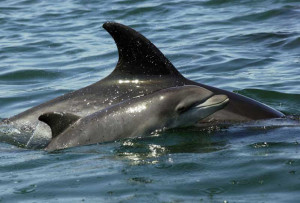 All this activity often attracts other whales that join the courtship procession and thus the pursuit begins. The escorting male tries to remain right next to the female while the others try to block him from doing so by pushing with their heads and hitting each other with their tails and fins. Each one tries to impress his rivals to be the one who, in the end, will remain with the female and earn the right to mate with her. This battle is rarely fatal and even though they do manage to hurt each other at times, usually it all ends with the surrender of the weakest. The victorious male mates with the female and remains with her just for a few days, after which he will look for another female while the female will also look for another male until she is impregnated.
All this activity often attracts other whales that join the courtship procession and thus the pursuit begins. The escorting male tries to remain right next to the female while the others try to block him from doing so by pushing with their heads and hitting each other with their tails and fins. Each one tries to impress his rivals to be the one who, in the end, will remain with the female and earn the right to mate with her. This battle is rarely fatal and even though they do manage to hurt each other at times, usually it all ends with the surrender of the weakest. The victorious male mates with the female and remains with her just for a few days, after which he will look for another female while the female will also look for another male until she is impregnated.
Once she is pregnant, the female will stay in tropical waters for a while and when the temperature of the water rises along with her hunger, she will simply set out on the voyage that will bring her to her feeding grounds, something that occurs around March or April.
The gestation period of a whale lasts 11 months so not all females are interested in the males when they reach the bay as some are already pregnant from the previous season. These look for shallow waters, devoid of strong currents and sufficiently protected for them to give birth. In the case of the Bay of Banderas, the whales head for the area located between Punta Mita and Bucerías as that entire zone is vital to the survival of this species in the bay.
Most of the calves are born around mid-December. The shallow waters provide them with protection and under the watchful eye of their mothers, they soon learn to swim better and follow their mothers wherever they may go. The mother whale keeps her calf no further away than 5 meters from her – the length of her pectoral fin – which gave rise to their scientific name: Megaptera Novaeangliae, which means long fins of New England, due to the length of their fins that resemble wings, and because this species was described for the first time in the New England area.
As the months pass, the calf acquires greater strength, feeding on the rich milk of its mother, of which it can drink over 50 liters a day. Its activity increases and it imitates every one of its mother’s movements, thus allowing us to see a real aquatic ballet when the mother decides to jump, followed by its little one. It is a most moving sight to see how the whales care for their young. Sometimes, they take them right out of the water atop their heads while they embrace them with their enormous fins.
 Little by little, the mother and her calf start to swim in deeper waters and, on occasion, they are accompanied by some male hoping for an opportunity to mate with her. This can become dangerous for the calves as they often find themselves involved in the battle between various males who want to mate with their mother who is trying desperately to move her calf away from them and swim away. Many calves die this way. In fact, their first year is the most difficult as that is when they are most vulnerable to large shark or orca attacks and due to the fatigue involved in their migration considering that with the arrival of spring, the whales must return to their feeding grounds. In the case of the whales that visit this bay, the feeding grounds are located in northern California and Oregon, though some go as far as Alaska.
Little by little, the mother and her calf start to swim in deeper waters and, on occasion, they are accompanied by some male hoping for an opportunity to mate with her. This can become dangerous for the calves as they often find themselves involved in the battle between various males who want to mate with their mother who is trying desperately to move her calf away from them and swim away. Many calves die this way. In fact, their first year is the most difficult as that is when they are most vulnerable to large shark or orca attacks and due to the fatigue involved in their migration considering that with the arrival of spring, the whales must return to their feeding grounds. In the case of the whales that visit this bay, the feeding grounds are located in northern California and Oregon, though some go as far as Alaska.
In Puerto Vallarta, whale watching has become more professional over the last few years and duly constituted companies offer tours to watch them, but even they must respect the norms in effect in Mexico that govern whale watching activities, norms aimed at protecting these fascinating animals.
Four basic norms must be respected in whale watching:
1. Do not get closer than 30 meters to the animals.
2. Do not remain with the same animals for longer than 30 minutes, especially if there are other vessels nearby.
3. If there are two vessels there when you reach them, it is better to look for another pod of whales.
4. Make sure that you go on an authorized vessel when you go whale watching. Authorized vessels fly a numbered flag with a seal of Mexico’s Department of Ecology – WHALES OBSERVATION .
One of the most amazing outdoor activity is the sight of whales. The most spectacular of them is the humpback whale for its jumps and playing around and its beautiful singing which is part of the mating process. Wildlife Connection offers you the opportunity of enjoying an encounter with these friendly giants which come to Puerto Vallarta to mate and take care of their breed year after year during winter.
Join Wildlife Connection, Puerto Vallarta to meet these magnificent creatures and help continue their valuable research.
“THESE GENTLE GIANTS DESERVE OUR RESPECT”
Wildlife Connections Vallarta Eduardo Lugo Photographer - Dolphins
Wildlife Connections Vallarta Eduardo Lugo Photographer - Dolphin Experience
Wildlife Connections Vallarta Eduardo Lugo Photographer - Dolphin Swim Experiernce
Wildlife Connections Vallarta Eduardo Lugo Photographer Heal with Dolphins
Wildlife Connections Vallarta Eduardo Lugo Photographer - Swim with dolphins
Wildlife Connections Vallarta Eduardo Lugo Photographer - Dolphins
Wildlife Connections Marina Vallarta Biologist Ma. Eugenia Rodriguez Whale Breaching
Wildlife Connections Marina Vallarta Biologist Ma. Eugenia Rodriguez Whale Experience
Wildlife Connections Marina Vallarta Biologist Ma. Eugenia Rodriguez

